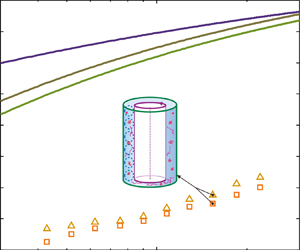Article contents
Global drag reduction and local flow statistics in Taylor–Couette turbulence with dilute polymer additives
Published online by Cambridge University Press: 03 January 2025
Abstract

We present an experimental study on the drag reduction by polymers in Taylor–Couette turbulence at Reynolds numbers ( $Re$) ranging from
$Re$) ranging from  $4\times 10^3$ to
$4\times 10^3$ to  $2.5\times 10^4$. In this
$2.5\times 10^4$. In this  $Re$ regime, the Taylor vortex is present and accounts for more than 50 % of the total angular velocity flux. Polyacrylamide polymers with two different average molecular weights are used. It is found that the drag reduction rate increases with polymer concentration and approaches the maximum drag reduction (MDR) limit. At MDR, the friction factor follows the
$Re$ regime, the Taylor vortex is present and accounts for more than 50 % of the total angular velocity flux. Polyacrylamide polymers with two different average molecular weights are used. It is found that the drag reduction rate increases with polymer concentration and approaches the maximum drag reduction (MDR) limit. At MDR, the friction factor follows the  $-0.58$ scaling, i.e.
$-0.58$ scaling, i.e.  $C_f \sim Re^{-0.58}$, similar to channel/pipe flows. However, the drag reduction rate is about
$C_f \sim Re^{-0.58}$, similar to channel/pipe flows. However, the drag reduction rate is about  $20\,\%$ at MDR, which is much lower than that in channel/pipe flows at comparable
$20\,\%$ at MDR, which is much lower than that in channel/pipe flows at comparable  $Re$. We also find that the Reynolds shear stress does not vanish and the slope of the mean azimuthal velocity profile in the logarithmic layer remains unchanged at MDR. These behaviours are reminiscent of the low drag reduction regime reported in channel flow (Warholic et al., Exp. Fluids, vol. 27, no. 5, 1999, pp. 461–472). We reveal that the lower drag reduction rate originates from the fact that polymers strongly suppress the turbulent flow while only slightly weaken the mean Taylor vortex. We further show that polymers steady the velocity boundary layer and suppress the small-scale Görtler vortices in the near-wall region. The former effect reduces the emission rate of both intense fast and slow plumes detached from the boundary layer, resulting in less flux transport from the inner cylinder to the outer one and reduces energy input into the bulk turbulent flow. Our results suggest that in turbulent flows, where secondary flow structures are statistically persistent and dominate the global transport properties of the system, the drag reduction efficiency of polymer additives is significantly diminished.
$Re$. We also find that the Reynolds shear stress does not vanish and the slope of the mean azimuthal velocity profile in the logarithmic layer remains unchanged at MDR. These behaviours are reminiscent of the low drag reduction regime reported in channel flow (Warholic et al., Exp. Fluids, vol. 27, no. 5, 1999, pp. 461–472). We reveal that the lower drag reduction rate originates from the fact that polymers strongly suppress the turbulent flow while only slightly weaken the mean Taylor vortex. We further show that polymers steady the velocity boundary layer and suppress the small-scale Görtler vortices in the near-wall region. The former effect reduces the emission rate of both intense fast and slow plumes detached from the boundary layer, resulting in less flux transport from the inner cylinder to the outer one and reduces energy input into the bulk turbulent flow. Our results suggest that in turbulent flows, where secondary flow structures are statistically persistent and dominate the global transport properties of the system, the drag reduction efficiency of polymer additives is significantly diminished.
JFM classification
Information
- Type
- JFM Papers
- Information
- Copyright
- © The Author(s), 2025. Published by Cambridge University Press
References
- 6
- Cited by


